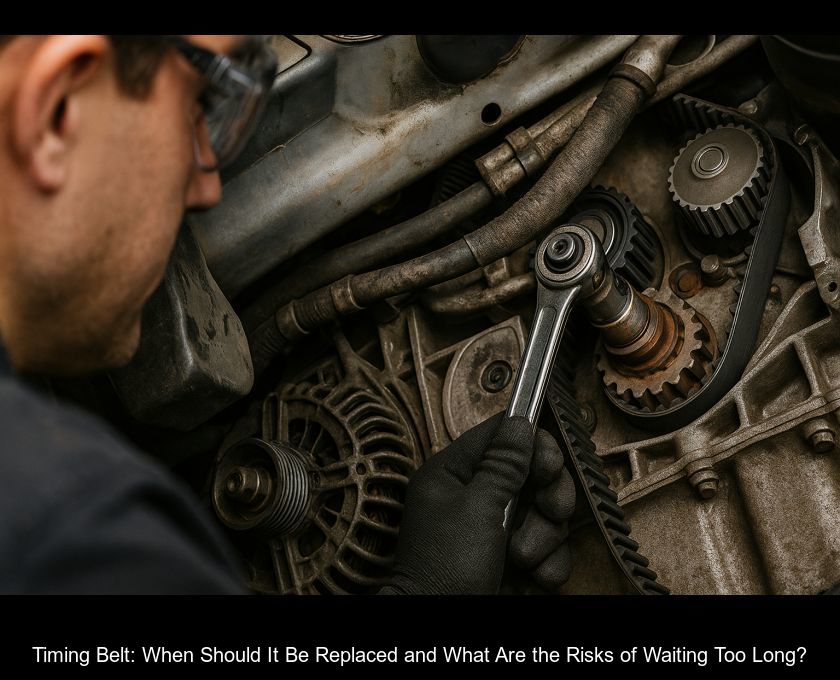Timing Belt: When Should It Be Replaced And What Are The Risks Of Waiting Too Long?
Replacing the timing belt is not the kind of expense that brings joy, we agree... but waiting too long can be very costly, sometimes an entire engine. Here are the proper mileage and time intervals, the wear signs to watch for, the factors that accelerate wear, and most importantly, what you risk if you postpone the maintenance.
The timing belt, a discreet yet vital component
At the heart of the engine, the timing belt synchronizes the crankshaft and camshafts so that pistons and valves work at the correct pace. It often drives other components, such as the water pump. Its material, a rubber-based composite, ages over time with heat and mechanical stress. When it fails, synchronization is lost instantly, and engine damage is inevitable in most modern engines.
If the due date is approaching for your car, ask for a timing belt quote now to schedule the service.
When to actually change it
There is no universal value, as each manufacturer publishes its own recommendations. In practice, remember two simple and complementary benchmarks to apply according to the first limit reached:
- The mileage - depending on the engines, the typical interval is between 60,000 km and 160,000 km.
- The duration - even if you drive little, generally count 5 to 6 years, sometimes more depending on the models and technical evolutions.
These ranges cover the majority of cases. Your maintenance logbook remains the authority, especially since some recent engines have had their recommendations evolve over time. A simple but effective tip: if you have just bought a used car and the history is not clear, have the timing belt checked immediately, or even replace it as a precaution.
You drive infrequently; time matters as much as the miles.
A belt also ages when stationary. Hot-cold fluctuations, micro-cracks, migration of plasticizers... the rubber loses its qualities, even with low annual mileage.
If you drive 8,000 km a year in the city, you will reach the age limit well before the mileage limit, and that's normal.
Signs of Wear Not to Ignore
A belt may seem silent until D-day, but certain symptoms should alert you:
- Unusual noises - regular snapping, metallic clicking, persistent whistling on the distribution side.
- Irregular operation - hard starts, power loss, jolting.
- Abnormal vibrations - especially at idle, sometimes with engine lights turning on.
These are weak signals that justify immediate inspection. A belt that breaks does not always give warning, but these signs increase your safety margin.
What wears out the belt faster
Repeated short trips - the engine does not reach its optimal temperature, moisture and condensation build up, oil and vapors stress the materials.
Extreme temperatures - heat waves, repeated freezing, prolonged outdoor parking.
Severe driving - over-revving, heavy loads, towing.
Pollutions and leaks - oil or coolant on the belt, it weakens quickly.
Specific design - some "wet" belts are immersed in oil, which requires strictly adhering to oil specifications and appropriate intervals.
Waiting too long, what concrete risks
In the majority of modern "interference" engines, a timing belt failure leads to piston-valve collisions. Common consequences include bent valves, the need to remove the cylinder head, or even replacing the entire engine. We're quickly talking about thousands of euros, not to mention the downtime and the cost of towing. In other words, delaying a preventive replacement that costs a few hundred euros can turn into an expensive bill and logistical nightmare.
How much does it cost, prevention vs cure
A preventive replacement of the timing belt kit typically costs a few hundred euros depending on the model and accessibility. Prices observed in the market generally range from roughly 400 euros to 1,000 euros for parts and labor depending on complexity, with variations due to labor time and additional parts. On the other hand, a failure can escalate to 3,000 euros to 5,000 euros when the cylinder head is damaged, and even more if the bottom end of the engine is affected. The simple yet essential moral of the story is that a planned replacement is far less expensive than an unexpected breakdown.
Should the water pump be changed at the same time?
Most often, yes, because the water pump is driven by the same belt. As long as everything is disassembled, replacing the pump, the pulleys, and the tensioner is a rational approach. A seized pump can strain the belt, a loose belt can wear out the pump... we prevent a domino effect by replacing the complete kit. That's why "timing belt kits" generally include the water pump.
Independent garage or manufacturer network, what about the warranty?
Good news, the European framework allows for maintenance at an independent repair shop without voiding the contractual warranty, provided that the maintenance plan is followed and original or equivalent parts are used. Keep all invoices and proof of service execution, as this is crucial. In any case, the service record book takes precedence, especially for timing belt intervals which are critical for engine longevity.
Lightning Checklist for Decision Making
1 - Open the maintenance log and locate the "timing belt" line for your engine.
2 - Record the last replacement date and mileage, or note the absence of information if you do not know.
3 - Determine where you stand in relation to the two limits, kilometers and years; the first limit reached prevails.
4 - If you are close to the due date, get a quote for the timing belt replacement and schedule an appointment, this will give you a clear view on the cost and timeframe.
5 - Take advantage of the disassembly to replace the complete kit, including the water pump, and leave with peace of mind.
And then
Record the date, mileage, and replaced parts. Slip this information into the glove compartment; it will be useful for the next technical inspection or when reselling. If you're interested, also read our article "Technical Inspection: What Changes From 2025" to anticipate upcoming changes.
Nota Bene
Belt vs Chain - A steel timing chain often lasts longer and requires less scheduled maintenance, but it can stretch or become noisy if lubrication has been neglected. A belt is lighter and quieter, but it's a wear item that needs replacement after a set period.
"Wet Belt" - In some recent engines, the belt operates in oil. It's a technical choice that comes with its benefits, but the oil must strictly comply with the recommended standard and be changed on time. Otherwise, the belt degrades faster.
Urban Use - Short trips mean unfavorable thermal cycles. If you mostly drive in the city, don't push the upper limits, stay cautious.
In summary
Don't panic, but don't be naive either. Distribution is a deadline to meet. A preventive replacement, done well and documented, protects your engine, your budget, and the value of your car. If the deadline is approaching, get a quote and avoid the breakdown that always happens at the worst possible time.








